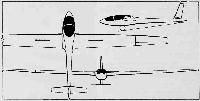
M.Hardy. Gliders & Sailplanes of the world
Siren E 75 Silene France
Designed by Siren SA, this side-by-side two-seater training sailplane of 18m span was originally known as the CERVA CE 75 Silene, the letters CERVA standing for Consortium Europeen de Realisation et de Ventes d'Avions, which was owned jointly by Siren SA and Wassmer-Aviation SA. Design of the Silene, which was the first French two-seater of glassfibre construction, began on 1 January 1972 and construction of the prototype by CERVA began on 1 February 1973; this first flew at Argenton on 2 July 1974. The Silene was intended to be suitable for all stages of training from ab initio to cross-country flights, and Siren SA was responsible for marketing it; by early 1978 40 Silenes had been ordered and six of them flown. But following the bankruptcy of Wassmer-Aviation, which built the wings and was the co-partner in CERVA, the President of Siren formed Societe Issorie-Aviation late in 1977, taking its title from Wassmer's Aerodrome d'Issoire works, to continue production of the Silene, now known as the Siren E 75, and the D 77 Iris. The first six Silenes had a retractable rubber-sprung monowheel but a non-retractable monowheel can if the customer desires also be fitted as optional, and a Siren hydraulic brake is optional; there is also a tailskid. French certification of the type was granted on 3 February 1978 and planned output for 1978 was two per month, with Siren SA building the fuselages. Construction is entirely of glassfibre/polyester/PMC sandwich, and the cantilever mid-set wings, of Bertin E55-166 aerofoil section, have 2° forward sweep at the quarter-chord line. The two-section ailerons have spring tabs and there are Schempp-Hirth air brakes above and below the wings. The fuselage is a semi-monocoque, and the two pilots' semi-reclining seats are slightly staggered, the starboard seat being a little to the rear, so as to keep fuselage width to a minimum; oxygen systems can be installed if desired. The rear section of the two-piece canopy is hinged to open to starboard, and is jettisonable. There is a low-set fixed-incidence tailplane with a spring tab in each elevator.
The E 78 Silene is a new variant featuring improved and roomier accommodation for the pilots, an enlarged cockpit canopy, lowered seats and a slight increase in available cockpit width; the E 78B is the same as the E 78 but with a fixed monowheel. This was followed by the 1 79 variant
which has flaps and provision for water ballast, and was under development in 1979. The modified wings incorporate carbon-fibre components, and the flaps, air brakes and monowheel are hydraulically actuated.
Data: E 75 Silene
Span: 59 ft 0 1/2in
Length: 26 ft 1 in
Height: 4 ft 11 in
Wing area: 193.8 sqft
Aspect ratio: 18.0
Empty weight: 805 lb
Max weight: 1,246 lb
Max speed: 124 mph (in smooth air)
Max aero-tow speed: 105 mph
Min sinking speed: 2.20 ft/sec at 56 mph
Best glide ratio: 38:1 at 59 mph
- M.Hardy. Gliders & Sailplanes of the world
Фотографии
-
Jane's All the World Aircraft 1976 / 03 - Sailplanes
CERVA CE.75 Silene side-by-side two-seat training sailplane
-
Jane's All the World Aircraft 1975 / 03 - Sailplanes
CERVA CE 75 Silene (Sagittaire) side-by-side two-seat training glider
- Фотографии

